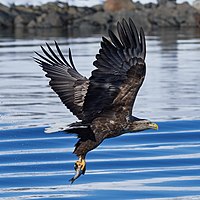
Photo from wikipedia
Abstract Complex coevolutionary relationships among competitors, predators, and prey have shaped taxa diversity, life history strategies, and even the avian migratory patterns we see today. Consequently, accurate documentation of prey… Click to show full abstract
Abstract Complex coevolutionary relationships among competitors, predators, and prey have shaped taxa diversity, life history strategies, and even the avian migratory patterns we see today. Consequently, accurate documentation of prey selection is often critical for understanding these ecological and evolutionary processes. Conventional diet study methods lack the ability to document the diet of inconspicuous or difficult‐to‐study predators, such as those with large home ranges and those that move vast distances over short amounts of time, leaving gaps in our knowledge of trophic interactions in many systems. Migratory raptors represent one such group of predators where detailed diet studies have been logistically challenging. To address knowledge gaps in the foraging ecology of migrant raptors and provide a broadly applicable tool for the study of enigmatic predators, we developed a minimally invasive method to collect dietary information by swabbing beaks and talons of raptors to collect trace prey DNA. Using previously published COI primers, we were able to isolate and reference gene sequences in an open‐access barcode database to identify prey to species. This method creates a novel avenue to use trace molecular evidence to study prey selection of migrating raptors and will ultimately lead to a better understanding of raptor migration ecology. In addition, this technique has broad applicability and can be used with any wildlife species where even trace amounts of prey debris remain on the exterior of the predator after feeding.
Journal Title: Ecology and Evolution
Year Published: 2019
Link to full text (if available)
Share on Social Media: Sign Up to like & get
recommendations!